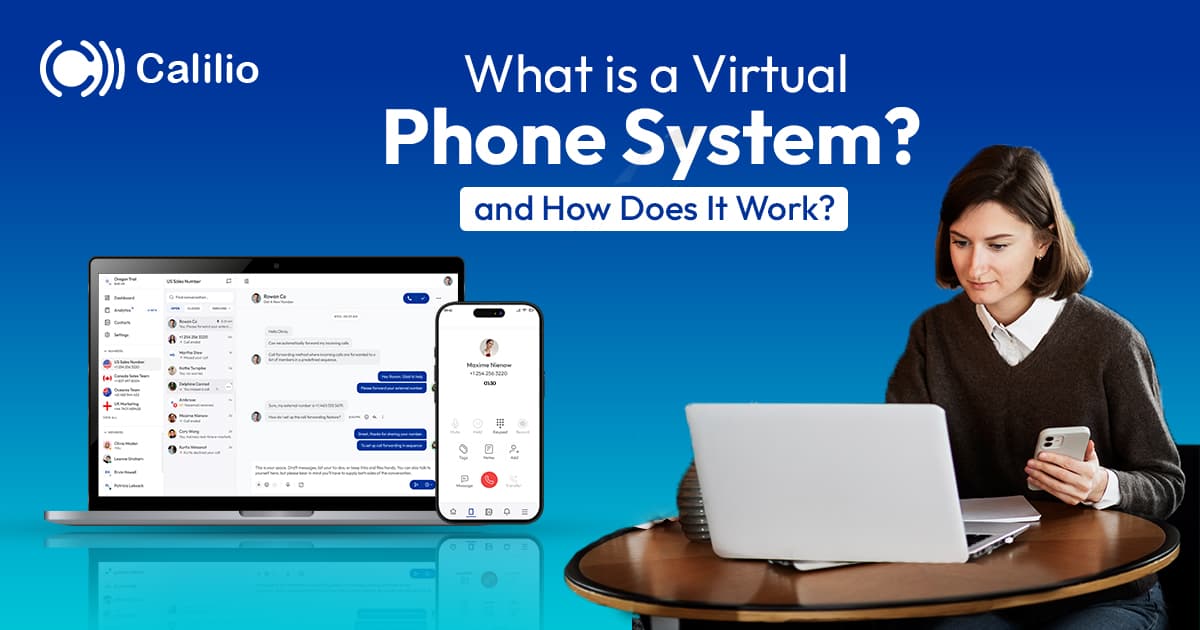What is a Virtual Phone System? A Comprehensive Guide

Every business seeks efficient communication methods, and a virtual phone system could be the answer. It leverages the Internet and enables companies to manage calls seamlessly without the constraints of traditional landlines. Whether you’re a startup or an established enterprise, a virtual phone system can pave the way for more efficient, scalable, and cost-effective communication.
Calilio is committed to assisting you in embracing this transformation, ensuring your business communication remains top-notch, regardless of where you or your team might be.
What is a Virtual Phone System?
A virtual phone system is a communication framework that allows businesses to receive calls and manage communication without being tied to traditional phone lines. It operates over the Internet and leverages Voice over Internet Protocol (VoIP) technology to transmit voice data as digital packets.
A virtual phone system is highly flexible. With no physical infrastructure like conventional telephone lines or switchboards, businesses can set up multiple lines, direct calls to various devices, and even operate internationally. It provides the capabilities of an advanced business phone system without the hefty infrastructure or costs.
How Does a Virtual Phone System Work?
A virtual phone system operates by converting voice signals into digital data packets. These packets are then transmitted over the internet using VoIP technology. Once they reach their destination, these data packets are converted back into voice signals, ensuring the recipient hears the message as intended.
This digital transformation allows the system to bypass traditional telephony infrastructure, reducing costs and increasing scalability. Moreover, given its cloud-based nature, users can access the system from anywhere with an internet connection. It offers unparalleled mobility and flexibility in managing business communications.
How Does a Virtual Phone System Differ From a PBX Phone System?
The debate between virtual phone systems and traditional PBX (Private Branch Exchange) systems has been ongoing. A virtual phone system, rooted in VoIP technology, leverages the internet to offer dynamic features that often outpace the capabilities of a conventional PBX system.
Traditional PBX systems have long been the backbone of business communication, utilizing physical connections and hardware. However, as businesses evolve in a digitally connected era, the limitations of PBX systems become more evident. The table below showcases key differences between a PBX phone system and a virtual phone system.
Factors | Virtual Phone System | PBX Phone System |
Infrastructure | Cloud-based; minimal physical hardware | Requires physical hardware and connections |
Scalability | Easily scalable without additional hardware | Expansion often needs hardware & installations |
Setup & Maintenance Cost | Lower initial cost; minimal maintenance | Higher initial cost; periodic maintenance |
Mobility | Accessible anywhere with an internet connection | Restricted to physical location of the system |
Features & Integration | Rich feature set; easy integration with tools | Limited features; harder to integrate |
Disaster Recovery | Data stored off-site; easy recovery | More vulnerable; relies on physical infrastructure |
International Calling | Cost-effective through virtual numbers | Typically more expensive |
User Experience | Intuitive interfaces; remote access | Often requires on-site management |
Benefits of Virtual Phone System For Small Business
A virtual phone system can provide numerous advantages, especially for small businesses looking to impact their industry. It presents a cost-effective alternative to traditional phone systems and offers various features tailored to address emerging businesses’ unique challenges.

1. Scalability on Demand
For growing businesses, a virtual phone system is a boon. It effortlessly scales to meet the ever-changing demands, allowing businesses to add or remove lines without major infrastructure overhauls. It ensures they only pay for what they use, optimizing operational costs.
2. Enhanced Mobility
In the age of remote work and global operations, mobility is key. A virtual phone system for small businesses ensures teams can communicate from anywhere, anytime. Whether on the field, at home, or traveling, the virtual business phone system guarantees seamless connectivity and productivity.
3. Advanced Features
Unlike traditional systems that may charge extra for advanced features, many virtual office phone systems include them in their standard packages. From call recording to CRM integrations, small businesses have access to tools that can enhance customer interactions and streamline operations.
4. Low Cost International Calls
One of the standout advantages of a virtual phone system is its ability to reduce the expenses associated with international calling. You can get virtual phone numbers in multiple countries on these business phone systems and bypass the traditionally high costs of overseas communication. Conversely, international clients and partners can reach these numbers without incurring international call charges.
5. Improved Customer Experience
Quick and effective communication is essential for customer satisfaction. A virtual business phone system offers features like automated attendants, call queuing, and call forwarding. These ensure that customer calls are handled professionally, reducing wait times and boosting overall satisfaction.
6. Disaster Recovery and Reliability
Natural disasters or technical glitches can disrupt business operations. However, with the cloud-based nature of virtual phone systems, data is stored securely off-site. It ensures continuity in communication, even when physical office spaces are compromised, safeguarding a business’ reputation and operations.
Drawbacks of Virtual Phone System
While virtual phone systems revolutionize business communication, understanding their potential drawbacks is essential. These systems aren’t immune to challenges, especially when considering a complete shift from traditional to cloud phone system.
- Dependence on Internet Connectivity: The primary requirement for a virtual phone system is a stable Internet connection. If the connection is inconsistent or slow, it can lead to dropped calls, voice lag, or poor call quality, hindering seamless communication.
- Initial Learning Curve: Transitioning to a virtual phone system might introduce a learning curve for employees accustomed to traditional systems. Proper training and familiarisation are essential to maximize the system’s benefits.
- Potential Costs of Advanced Features: While basic features are typically inclusive, some advanced VoIP features may come at an added cost. Scrutinizing pricing models ensures the chosen package aligns with your business requirements and budget.
- Security Concerns: Being cloud-based, there could be concerns about the security and privacy of conversations. Choosing providers like Calilio is essential. We prioritize robust encryption and security protocols.
- Hardware Investments: While a virtual phone system reduces the need for extensive physical infrastructure, businesses may still need to invest in compatible devices or headsets to guarantee the best call quality.
- Security Concerns: Being cloud-based, there could be concerns about the security and privacy of conversations. Choosing providers like Calilio is essential. We prioritize robust encryption and security protocols.
- Hardware Investments: While a virtual phone system reduces the need for extensive physical infrastructure, businesses may still need to invest in compatible devices or headsets to guarantee the best call quality.
Features of a Virtual Phone System
A virtual phone system is a powerhouse of features tailored to enhance and simplify business communications. It allows businesses to enjoy advanced functionalities that modernize their operations and facilitate better relationships with clients and partners. Below are listed the top 10 VoIP features of a virtual phone system.
1. Unified Callbox
A centralized system where all call-related data, voicemails, missed calls, and recorded conversations are stored. A unified callbox ensures businesses can quickly access call-related information, streamlining operations and improving response times.
2. Call Monitoring
The call monitoring feature enables supervisors or managers to listen to live calls without knowing the parties involved. This real-time supervision is crucial for training, quality assurance, and upholding consistent communication standards.
3. Sentiment Analysis
Sentiment analysis is an advanced feature that evaluates the mood or sentiment of a caller by analyzing their voice tone and choice of words. It gives businesses valuable insights into customer satisfaction and areas of improvement, making it easier to tailor solutions and responses accordingly.
4. Cloud-Based Operation
Virtual phone systems operate in the cloud, eliminating the need for hefty on-site equipment. This cloud-centric approach ensures accessibility from anywhere, guaranteeing uninterrupted communication regardless of your geographical location.
5. Call Forwarding
Direct incoming calls to various devices or numbers based on predefined rules. Whether routing calls to another department or forwarding them to an employee’s mobile when they’re out of the office, call forwarding ensures no call goes unanswered.
6. Auto-Attendant
A virtual receptionist greets callers and guides them through menu options. The auto-attendant feature ensures a professional first impression while efficiently directing calls to the appropriate department or individual.
7. Multi-Level IVR
An Interactive Voice Response (IVR) system helps manage high call volumes by routing callers based on their input, ensuring they reach the right department or individual without delay.
8. Call Recording
For training or compliance purposes, businesses can record calls. Call recording helps maintain quality assurance and provides a reference for disputes or clarifications.
9. Call Analytics
Harness the power of data with comprehensive call analytics. Track call durations, peak calling times, missed calls, and more to understand client behavior and optimize your communication strategies.
10. CRM Integration
Seamlessly integrate with Customer Relationship Management (CRM) software. It allows better client engagement, keeping track of previous interactions, and ensuring personalized communication.
Calilio: The Best Virtual Phone System For Small Business
Adapting and evolving with technology is imperative for seamless business communication. With all the compelling reasons and tangible benefits discussed, it’s evident that a virtual phone system is more than just a contemporary solution—it’s the future.

Get Cashbacks Up to 43% Straight To Your Wallet!
Unlimited Virtual Numbers – Local, Mobile & Toll-Free from 100+ Countries
Free Local Phone Number from US or Canada
Crystal-Clear Calls Starting at Just $0.0153/min
24/7 Human Support – Because Great Service Never Takes a Holiday


Frequently Asked Questions
What is the best phone system for small businesses?
The best phone system for small businesses often depends on the business's specific needs and budget. However, many small businesses are turning to virtual phone systems, like Calilio, because they offer flexibility, scalability, and cost-saving benefits. These systems are internet-based, easy to set up, and have advanced features that cater specifically to the needs of small businesses.
What is the difference between VoIP and virtual phone system?
How do I set up a virtual phone system?
Can I get a virtual phone number for my business?
How much does a virtual phone system cost for a small business?

Still have questions?
Can’t find the answer you’re looking for? Please chat with our friendly team.
Stay in the loop
Get the latest call insights, trends, and updates delivered straight to your inbox.
By subscribing, you agree to receive updates from Calilio.
You can unsubscribe anytime.